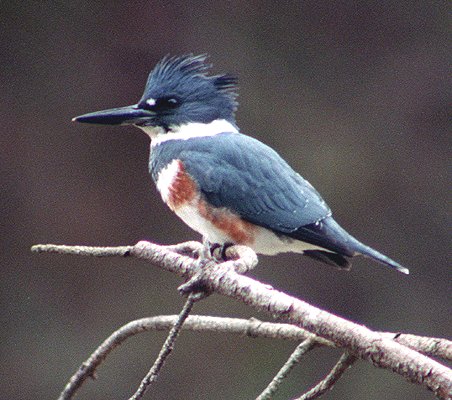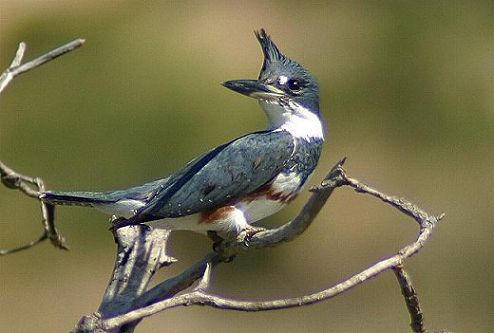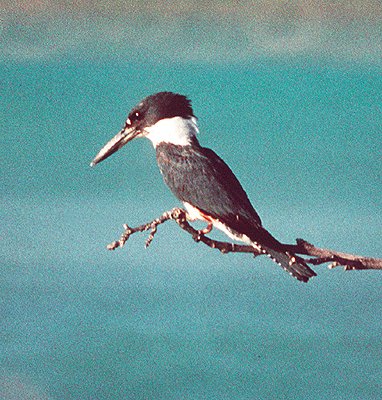|
Belted Kingfisher Ceryle alcyon Martín Pescador Bandeado
|
 |
|
Female - Photo: J. Wilson
|
|
Belted Kingfisher Ceryle alcyon Martín Pescador Bandeado
|
 |
|
Female - Photo: J. Wilson
|
|
IDENTIFICATION: The kingfisher has blue upper parts with a white collar. The underparts are white with a blue breast band. The female has an additional rusty-brown breast band below the blue one. The bill is large and stout, and the bird often raises its crest, giving it a big-headed appearance, almost like a woodpecker. When flying, it can be recognized from a distance by bursts of wingbeating. Length: 28-35 cm.; weight: 140-170 g. VOICE: A rattly, "klek" note, usually repeated in a long series. Audio (M. Oberle). HABITAT: Ponds, lagoons, rivers and ocean shores: wherever the water is clear enough to see fish just below the surface. HABITS: The kingfisher perches on exposed tree branches, wires, or posts over water. It dives for prey either directly from its perch or after a brief, hovering flight. It uses its stout bill to catch fish, crustaceans, aquatic insect larvae, and sometimes even lizards or small birds and mammals. Most fish are less than 10 cm. long and are caught within 60 cm. of the water’s surface. It regurgitates pellets with undigested bones and fish scales. Both sexes defend a feeding territory against other kingfishers. The Belted Kingfisher nests in North America in a 1-2 meter long burrow that both sexes dig in a mud bank. Sometimes even sand dunes or sawdust piles have been used as nest sites. Two of the kingfisher’s toes are partially fused together, which aids in shoveling earth for the nest burrow. Over a 22-24 day period, both sexes incubate the 6-7 white eggs. In the first few days after the eggs hatch, the parents regurgitate digested food, but as the chicks grow, the parents gradually bring larger fish. The young birds defecate against the wall of the nest chamber, but then cover the feces with dirt from the burrow wall. The chicks leave the nest 27-29 days after hatching. The adults gradually reduce the feeding schedule and then entice the young to leave the nest by perching just outside the nest entrance while holding a fish in the bill. For the first few weeks after leaving the nest, the parents feed the young and teach them to fish by dropping prey in the water for the young to chase. STATUS AND CONSERVATION: Common winter visitor, although a few non-breeding individuals linger throughout the year. In the kingfisher’s breeding range, human activities such as the creation of reservoirs and gravel pits may have increased breeding opportunities. RANGE: Breeds over most of North America. It retreats from most of its northern breeding range in winter and heads as far south as the West Indies and northwestern South America. A regular location in winter is at La Parguera. TAXONOMY: ALCEDINIDAE; Cerylinae |
 |
|
Photo: A. Sánchez Muñoz
|
 |
|
Photo: A. Sánchez Muñoz
|
 |
|
Photo: A. Sánchez Muñoz
|
 |
|
|
Photo: M. Oberle
|
|
References Arendt, W.J. 1992. Status of North American migrant landbirds in the Caribbean region: a summary. Pp. 143-171 in Ecology and conservation of neotropical migrant landbirds (J.M. Hagan III and D.W. Johnston, eds.) Smithsonian Instit. Press, Washington, D.C. Bent, A.C. 1940. Life histories of North American cuckoos, goatsuckers, hummingbirds and their allies. Smithsonian Instit. U.S. National Museum Bull. 176. (Reprinted by Dover Press, NY 1964). del Hoyo, J., A. Elliott, and J. Sargatal, eds. 2001. Handbook of Birds of the World, Vol. 6. Mousebirds to hornbills. Lynx Edicions, Barcelona. Fry, C.H., K. Fry, and A. Harris. 1992. Kingfishers, bee-eaters & rollers: a handbook. Princeton University Press, Princeton, NJ. Hamas, M. J. 1994. Belted Kingfisher (Ceryle alcyon). No. 84 in The birds of North America (A. Poole and F. Gill, eds.). Acad. Nat. Sci., Philadelphia, PA, and Am. Ornithol. Union, Washington, D.C. Pérez-Rivera, R.A. 1980. Algunas notas sobre migración de aves en Puerto Rico. Science-Ciencia 7(4):123-126. Raffaele, H.A. 1989. A guide to the birds of Puerto Rico and the Virgin Islands. Princeton. Raffaele, H.A. 1989. Una guía a las aves de Puerto Rico y las Islas Vírgenes. Publishing Resources, Inc., Santurce, PR. Raffaele, H.A., J.W. Wiley, O.H. Garrido, A.R. Keith, and J.I. Raffaele. 1998. Guide to the birds of the West Indies. Princeton. Belted Kingfisher, Spanish text Next related species in taxonomic order Previous related species in taxonomic order |